Group Cost Malmquist Productivity Index: A Case Study of Bank Industry
To evaluate the achievement degree of an organization to its goals, its productivity must be measured. Since an organization is composed of different groups, the productivity of its groups should be examined. This paper aims to introduce a suitable index to evaluate group cost productivity changes and identify factors affecting it. To explain the applicability of the proposed index, a study on the productivity evaluation of a bank's branches in different regions is presented.
A suitable distance function is created to measure the cost efficiency of a group, and based on that, the group cost Malmquist index is introduced. Then, the influencing factors on the productivity growth of the groups are examined by focusing on intra-group and extra-group sections.
An indicator was presented to evaluate the cost productivity changes of a group of decision-making units and the factors that affect the cost productivity changes of the groups were identified. The proposed group Malmquist index breaks down into four components: Pure efficiency changes, scale efficiency changes, allocative efficiency changes, and cost technological changes. The pure efficiency change measures the optimal use of inputs to produce output indicators. The scale efficiency changes reflect the effect of changes in the size of branches of a region on its productivity growth. The allocative efficiency changes indicate the achieved changes in the optimal combinations of inputs considering the prices of each period. The cost technological changes component reflects changes in cost technology frontiers during two periods. All of these components were examined from two perspectives: intra-group and extra-group. In the intra-group perspective, the internal group frontier is considered, and in the extra-group perspective, the common frontier of all groups is focused. To explain the applicability of the proposed index and calculate the impact of its components on productivity growth, a real case study was presented. This case study evaluated the cost productivity changes of a bank's branches in eight different regions. The results showed that three regions have cost productivity growth. One area has almost no changes in cost productivity, and the other regions have productivity regressions. The results of measuring the group cost Malmquist productivity index on bank data provide meaningful and useful information about bank productivity changes in different areas.
Most organizations consist of different groups and departments. Sometimes, it is necessary to examine a group of decision-making units instead of evaluating the performance of several decision-making units to analyze the role of environmental conditions on the performance assessment of the decision-making units. The results are shown that the proposed group cost Malmquist productivity index provides a suitable tool for evaluating the cost productivity changes of groups. Also, it prepares a clear perspective for managers of organizations for future policies by identifying the intra-group and extra-group factors affecting group cost productivity changes.
- حق عضویت دریافتی صرف حمایت از نشریات عضو و نگهداری، تکمیل و توسعه مگیران میشود.
- پرداخت حق اشتراک و دانلود مقالات اجازه بازنشر آن در سایر رسانههای چاپی و دیجیتال را به کاربر نمیدهد.


